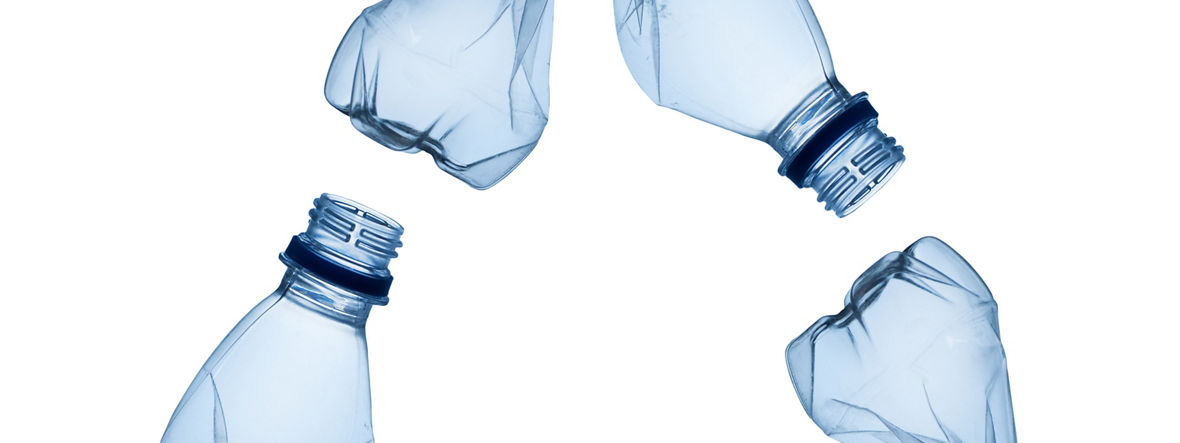Mr. Sartorius, your association is now celebrating the hundredth anniversary of plastic. Let’s take a quick look at the future: Will the world still need plastic 100 years from now?
INGO SARTORIUS Plastic is an irreplaceable part of our daily lives. This material is versatile and effective—qualities that also benefit the environment, by the way. Lightweight construction in cars decreases emissions and thus reduces the strain on the climate. That also applies to building insulation. In the fields of medicine and packaging, plastics are highly efficient materials that offer safety and hygiene protection.
BERNHARD BAUSKE Ever since the 1950s, plastics have had an incomparable career of success. The amount of plastic we produce annually corresponds roughly to the weight of the entire human race. That’s because this material is very versatile and effective—in that regard I agree with Mr. Sartorius. The crucial disadvantage of plastics is that they aren’t biodegradable.Even in Germany, where waste management works fairly well, almost 450,000 tons of plastic end up in the environment every year. Three quarters of that is in the form of microplastics.
What does that mean?
BAUSKE In the places where plastic ends up in the environment, it accumulates. As a result, the burden on the natural environment is steadily increasing. We’re even finding plastic particles and used packaging materials in the Arctic and the deep sea. No matter how many nature preserves you set up, plastics always find a way to get inside, harming the ecosystems and the animals that live in them.
SARTORIUS It’s unacceptable for plastic waste to enter the environment and the oceans. It’s a fact that we need to find solutions. And our industry is helping to develop them.
BAUSKE But surely the first step must be to stop producing plastics in the first place! And that means there where you find large volumes of plastic that quickly become waste: disposable products. In the case of a single-use bag it doesn’t matter whether it’s made of plastic or paper. The life cycle assessment of a paper bag might even be worse. That’s why one of our demands is for the complete avoidance of single-use bags.

Theoretically, we could reuse plastic over and over again.
BAUSKE Theoretically, yes. But I’m skeptical as to whether we will ever develop a genuine circular economy with plastics while maintaining the ways we produce and use them today.
Why?
BAUSKE Plastic is effective, but it’s also very complex. Some plastic products contain between 40 and 200 different additives. Because of the differing material properties, it’s not easy to recycle this material. This is where we have to harmonize our efforts.
When researchers develop new materials in order to meet very specific requirements, they often work with plastics—for ackaging just as for bone implants. Are we running the risk of having to limit these possibilities in the future?
SARTORIUS Absolutely! Of course plastics are developed and produced not in order to become waste at some point, but because of the benefit they bring to their respective applications. The Gesellschaft für Verpackungsmarktforschung (Society for Packaging Market Research) in Wiesbaden has found out that in Germany innovations alone have saved about a million tons of industrial packaging materials annually over the past 20 years. To put it another way, over a fourth of potential plastic content is avoided before the product even goes to market. However, it’s true that the greater complexity of these optimized packaging materials creates a difficulty. For example, there are specialized multilayer composites that make it difficult to recycle these materials.
BAUSKE This is an important pair of conflicting goals. A very thin packaging material requires fewer fossil resources. But because the layers can’t be separated or usefully recycled together, the packaging ultimately ends up in a waste incineration plant. If the current development continues, in the future between 10 and 13 percent of the CO2 budget we’re permitted to use for reaching the 1.5°C climate target will be taken up solely by the production and incineration of plastics.
Will new bioplastics bring us closer to a solution?
BAUSKE Unfortunately, no. Just the production of bio-based raw materials for plastics can be problematic. I’m thinking of the use of pesticides, social problems in the countries where the raw materials are extracted, and competition with food production. In addition, bio-based plastics are not biodegradable in themselves. The most important factor is keeping plastics in circulation for a long time.

And what about biodegradable plastics?
BAUSKE Even biodegradable plastics harbor problems.When they are in cold saltwater, they don’t disintegrate anywhere near as fast as they do in warm compost heaps. Besides, they are not welcome in industrial composting plants, because the decomposing times there are much too short. Today German composting plants usually screen out every bit of plastic because they can’t know whether a given type of plastic breaks down or not. In other words, even a biodegradable plastic bag is fished out and incinerated. Moreover, consumers feel encouraged to simply discard packaging made of biodegradable plastics somewhere outdoors. Biodegradable plastics should be used only in areas where it’s difficult to retrieve them, such as in agriculture and forestry.
ELEMENTS-Newsletter
Receive exciting insights into Evonik's research and its social relevance - conveniently by e-mail.
SARTORIUS Of course consumers should definitely not be encouraged to litter. However, we can’t compare the waste disposal system in Germany with those of other countries. We’ve got extremely varied waste disposal systems in Europe. In Italy, for example, there is an established protocol for dealing with plastics that are certified as compostable, ranging from production to handling and all the way to composting or fermentation facilities. It’s important to make sure that collection and sorting systems are adapted to these materials and that they don’t interfere with other established recycling routes.
So what does the path toward a circular economy look like?
BAUSKE The first step, which is also being promoted by the WWF, would be an international treaty that obligates states to prevent the dumping of any more plastic waste into the oceans. That’s actually a relatively simple and manageable demand. But it requires countries to get to grips with their waste management systems.
In order to do that, they need support and the transfer of know-how. Secondly, we urgently need an expanded system of producer accountability, and a legal framework must be created for this at the national level. Thirdly, McKinsey and the Ocean Conservancy environmental protection association discovered a few years ago that in Southeast Asia about 80 percent of the plastic in packaging waste holds very little value for garbage collectors. As a result, it’s usually disposed of at illegal dump sites, and from there it seeps into the environment. That’s why we have to make sure that plastic foils and other materials are sufficiently valuable to ensure that they will be collected and reprocessed into similar products.
What can the producers do in order to reach this goal?
SARTORIUS Product design is one of the essential keys that producers need in order to improve their performance in this area. Take for example the familiar pouch bags that are used as refill packs for liquid soap and dog food. They have to fulfill extremely stringent requirements in supermarkets. They’re not supposed to burst or leak, even if they fall from a great height. Here it would be possible to make sensible compromises in order to find simpler and more environmentally friendly solutions. Instead of needing to last for two years, this kind of packaging might need to last for only six months.
In that case, you would no longer need nine layers of foil; you’d only need five. The crucial difference is that we could bind these different layers together so that the materials are compatible with each other. Then, after the packaging has been used, everything can be recycled together.
Can you manage to do that?
SARTORIUS With our know-how, that’s completely doable. It’s essential for the material developers and the designers to work together. That’s why we participate, among other things, in the Eco Design of Plastics Packaging Round Table, which has already developed guidelines for such collaboration. But products like these also have to be paid for.
How can chemical recycling help to solve the compatibility problems?
SARTORIUS We want to retain the material properties of plastic as much as possible. That’s why we have to initially give priority to mechanical recycling processes—whether that means melting and then granulating the plastic or using new processes to dissolve the long-chain polymers, filter out impurities, and precipitate the polymers once again. That scarcely changes the polymer chain.
This process is different from chemical processes, in which polymer chains are split apart and then the tiny components are used to produce new plastics.
Wouldn’t that be an alternative?
SARTORIUS Of course, there’s a lot of potential there. The research is ongoing, and the plastic producers are working on various scientific projects together with the chemical industry, users, and recyclers. At the moment we’re mainly focusing on technologies such as solvolysis, depolymerization, and pyrolysis.

BAUSKE We are rather skeptical about this method. Chemical recycling is being proposed again and again as the solution to our waste problems, but it’s actually not a new idea. Processes such as pyrolysis are very complex. These facilities, and especially their input, need to be very precisely managed. Simply collecting waste and dumping it into the facility doesn’t work. If I need to painstakingly sort the incoming materials, I might as well be doing mechanical recycling. But I don’t mind admitting that the promise of producing new materials consisting of “clean” molecules sounds very appealing.
But…?
BAUSKE But the questions remain: Can this be technically implemented on a large scale as well? Are the costs competitive? What happens to the production waste? Ultimately we also need to take a critical look at the energy balance sheet and other environmental parameters.
SARTORIUS Of course many questions still remain unanswered. But we shouldn’t lump all chemical recycling processes together in the same basket. Depending on the individual process, the life cycle assessments can turn out to be very different. In particular, we’re addressing residual waste fractions that are generated in households as well as industrial and commercial facilities. Then we’ll find ways to extract valuable materials that until now could only be utilized as fuel. We are conducting intense research to this end, for example at the Karlsruhe Institute of Technology, where we are participating in a major consortium.
BAUSKE Research is good, and I’m not opposing it.However, it won’t save us in the next ten years. There’s no alternative to avoiding waste, replacing materials, and expanding mechanical recycling by every means possible—especially by improving collection and sorting systems.

If you could write the laws yourself, how could these problems be solved?
BAUSKE In countries whose waste management systems are not well developed, we need a legal framework for expanded producer responsibility, like the one we have in Germany. Companies that put products and packaging on the market are responsible for collecting these materials at the end of their life cycle, sorting them, and recycling them. The WWF is providing focused support to Southeast Asian governments as they acquire the necessary know-how and build the systems they need. A licensing system for packaging could provide support for the waste management industry, which is currently underfunded, as well as providing the necessary steering effect. We also should see whether it makes sense to tax petroleum-based plastics in the same way we tax other petroleum products.
Additional taxes? Why?
BAUSKE Fresh materials compete directly with recycling materials, which become more attractive as a result. This is important, especially in countries that have a large informal waste management sector. For example, in Indonesia and Vietnam many people make a living by collecting valuable plastic materials and bringing them to recycling facilities. If this work ceases to pay, they will stop doing it. As a result, the market will suddenly collapse, and so will the waste collection process. And then we will once again find these materials in the environment.
So we should we tax petroleum-based products in order to make fresh plastic more expensive?
SARTORIUS I think this option is problematic. It would also raise the prices of the plastics that are used in lightweight construction materials to protect the climate or are wonderfully easy to recycle, for example. We’re familiar with the discussion about paper bags and plastic bags—in which plastic bags are in a much better position in terms of the circular economy. That also applies to PET bottles, which consist of a single plastic and for which there has long been an established materials cycle. It’s important to continue expanding the existing circular economy and to develop new recycling solutions in a process that is open to all types of technology. Further possibilities should also be expanded in other application areas besides the packaging sector. That will enable us to create a genuine circular economy faster. Plastic in particular has what it takes to do that.



